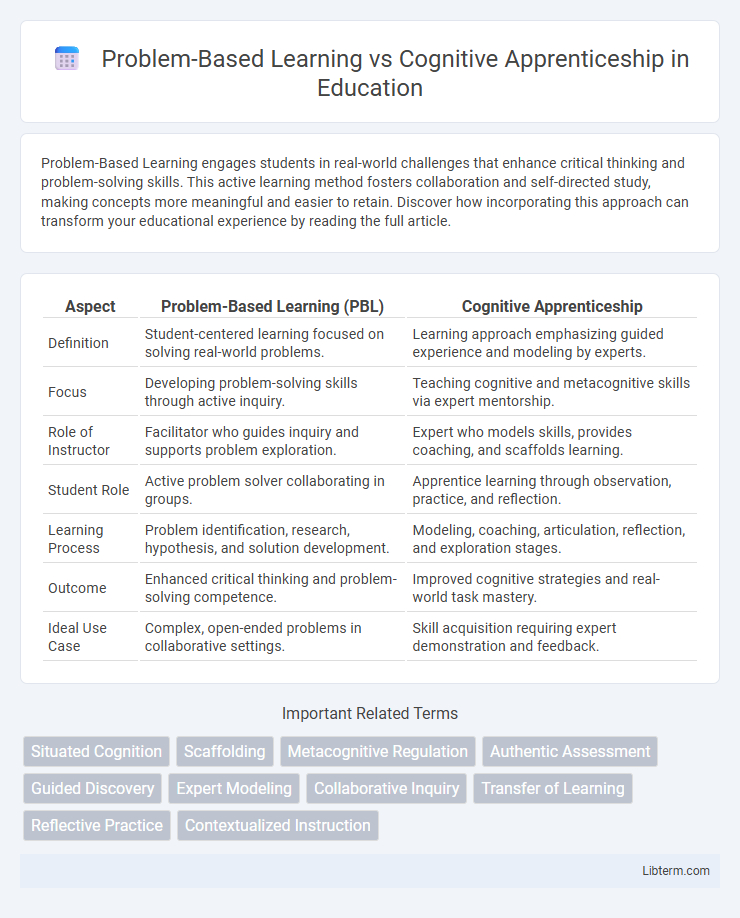Problem-Based Learning engages students in real-world challenges that enhance critical thinking and problem-solving skills. This active learning method fosters collaboration and self-directed study, making concepts more meaningful and easier to retain. Discover how incorporating this approach can transform your educational experience by reading the full article.
Table of Comparison
| Aspect | Problem-Based Learning (PBL) | Cognitive Apprenticeship |
|---|---|---|
| Definition | Student-centered learning focused on solving real-world problems. | Learning approach emphasizing guided experience and modeling by experts. |
| Focus | Developing problem-solving skills through active inquiry. | Teaching cognitive and metacognitive skills via expert mentorship. |
| Role of Instructor | Facilitator who guides inquiry and supports problem exploration. | Expert who models skills, provides coaching, and scaffolds learning. |
| Student Role | Active problem solver collaborating in groups. | Apprentice learning through observation, practice, and reflection. |
| Learning Process | Problem identification, research, hypothesis, and solution development. | Modeling, coaching, articulation, reflection, and exploration stages. |
| Outcome | Enhanced critical thinking and problem-solving competence. | Improved cognitive strategies and real-world task mastery. |
| Ideal Use Case | Complex, open-ended problems in collaborative settings. | Skill acquisition requiring expert demonstration and feedback. |
Introduction to Problem-Based Learning and Cognitive Apprenticeship
Problem-Based Learning (PBL) centers around student-driven inquiry where learners tackle real-world problems to develop critical thinking and problem-solving skills. Cognitive Apprenticeship emphasizes learning through guided experiences and social interaction, where experts mentor novices in authentic tasks, fostering skill acquisition within context. Both approaches prioritize active learning but differ in structure: PBL promotes independent exploration, while cognitive apprenticeship relies on modeling and scaffolding by experts.
Theoretical Foundations of Each Approach
Problem-Based Learning (PBL) is grounded in constructivist theories emphasizing learner-centered inquiry, where students develop critical thinking through real-world problem solving. Cognitive Apprenticeship draws on social learning theory and situated cognition, highlighting the importance of guided practice and modeling within authentic contexts to develop expertise. Both approaches leverage active learning but differ in their focus on independent problem exploration versus scaffolded mentorship to enhance cognitive skill development.
Key Principles of Problem-Based Learning
Problem-Based Learning (PBL) centers on student-driven inquiry where learners engage with real-world problems to develop critical thinking and problem-solving skills through collaboration and self-directed research. It emphasizes scaffolding knowledge by guiding students to identify learning gaps and apply interdisciplinary concepts rather than passive absorption of information. Key principles include authentic problems, learner autonomy, collaborative learning, and reflective practice, distinguishing it from Cognitive Apprenticeship, which primarily focuses on modeling expert processes and situated learning through guided mentorship.
Core Components of Cognitive Apprenticeship
Cognitive Apprenticeship centers on modeling, coaching, scaffolding, articulation, reflection, and exploration, enabling learners to develop cognitive and metacognitive skills in authentic contexts. These core components emphasize guided experience and gradual transfer of responsibility, contrasting with Problem-Based Learning's focus on student-driven inquiry and problem-solving. Understanding these elements highlights how Cognitive Apprenticeship fosters deeper skill acquisition through expert-novice interactions and contextualized learning.
Comparing Instructional Strategies
Problem-Based Learning (PBL) emphasizes student-centered inquiry where learners actively solve real-world problems to develop critical thinking and collaborative skills. Cognitive Apprenticeship focuses on modeling expert thinking processes through guided practice, scaffolding, and coaching to build domain-specific expertise. Both instructional strategies prioritize active engagement but differ in approach; PBL fosters autonomous problem-solving, while Cognitive Apprenticeship provides structured support mimicking expert-novice interactions.
Facilitating Learner Engagement
Problem-Based Learning facilitates learner engagement by presenting real-world problems that stimulate critical thinking and collaborative problem-solving among students. Cognitive Apprenticeship enhances engagement through guided, context-rich mentorship where learners observe, practice, and receive expert feedback in authentic tasks. Both approaches prioritize active participation but differ in structure, with Problem-Based Learning emphasizing student-driven inquiry and Cognitive Apprenticeship focusing on scaffolded skill development within expert-novice interactions.
Assessment Methods in Both Models
Problem-Based Learning (PBL) assessment methods emphasize real-world problem-solving skills, using formative evaluations like group reflections, self-assessments, and peer reviews to measure critical thinking and application of knowledge. Cognitive Apprenticeship assessments focus on authentic tasks, utilizing performance-based evaluations such as observation of expert-novice interactions, guided practice assessments, and feedback during real-time problem-solving to gauge skill acquisition and cognitive processes. Both models prioritize competency through contextualized assessment techniques that reflect learners' abilities to apply knowledge in practical scenarios.
Benefits and Challenges of Problem-Based Learning
Problem-Based Learning (PBL) promotes critical thinking and problem-solving skills by engaging students in real-world scenarios, enhancing their ability to apply knowledge effectively. Challenges of PBL include the potential for uneven group participation and the need for skilled facilitators to guide inquiry without direct instruction. This approach contrasts with Cognitive Apprenticeship, which emphasizes expert modeling and scaffolding, potentially offering more structured support for novices but less emphasis on autonomous problem-solving.
Strengths and Limitations of Cognitive Apprenticeship
Cognitive apprenticeship excels in providing hands-on, contextual learning through guided experiences, fostering deep understanding and skill transfer by modeling expert thought processes. Its strength lies in scaffolding complex cognitive tasks within authentic settings, though it can be limited by the availability of expert mentors and the intensive time commitment required. Unlike Problem-Based Learning, which emphasizes student-driven problem solving, cognitive apprenticeship demands structured mentor involvement, potentially restricting scalability in larger educational environments.
Choosing the Right Approach for Your Educational Context
Selecting between Problem-Based Learning (PBL) and Cognitive Apprenticeship depends on the specific educational goals and learner needs. PBL emphasizes student-driven problem-solving and critical thinking in real-world scenarios, ideal for fostering independent inquiry in higher education and professional training. Cognitive Apprenticeship integrates expert modeling, coaching, and scaffolding, making it effective for skill acquisition in hands-on or vocational contexts where guided practice and tacit knowledge transfer are crucial.
Problem-Based Learning Infographic

 libterm.com
libterm.com